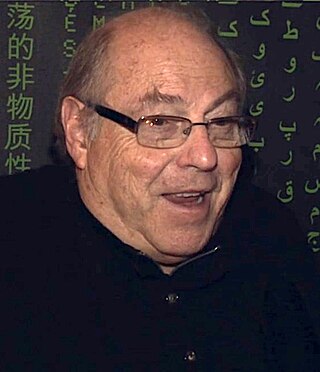Software art is a work of art where the creation of software, or concepts from software, play an important role; for example software applications which were created by artists and which were intended as artworks. As an artistic discipline software art has attained growing attention since the late 1990s. It is closely related to Internet art since it often relies on the Internet, most notably the World Wide Web, for dissemination and critical discussion of the works. Art festivals such as FILE Electronic Language International Festival, Transmediale (Berlin), Prix Ars Electronica (Linz) and readme have devoted considerable attention to the medium and through this have helped to bring software art to a wider audience of theorists and academics.

Adobe Creative Suite (CS) is a discontinued software suite of graphic design, video editing, and web development applications developed by Adobe Systems.

Manfred Mohr is a German artist considered to be a pioneer in the field of digital art. He has lived and worked in New York since 1981.
The Prix Ars Electronica is one of the best known and longest running yearly prizes in the field of electronic and interactive art, computer animation, digital culture and music. It has been awarded since 1987 by Ars Electronica.

David Rokeby is a Canadian artist who has been making works of electronic, video and installation art since 1982. He lives with his wife, acclaimed pianist Eve Egoyan, in Toronto, Canada.

Threadless is an online community of artists and an e-commerce website based in Chicago, Illinois, founded in 2000 by Jake Nickell and Jacob DeHart.

Roy Ascott FRSA is a British artist, who works with cybernetics and telematics on an art he calls technoetics by focusing on the impact of digital and telecommunications networks on consciousness. Since the 1960s, Ascott has been a practitioner of interactive computer art, electronic art, cybernetic art and telematic art.
Eyebeam is a not-for-profit art and technology center in New York City, founded by John Seward Johnson III with co-founders David S. Johnson and Roderic R. Richardson.
Michael Joaquin Grey is an American artist, inventor, and educator based in New York City.

Ellen Lupton is a graphic designer, curator, writer, critic, and educator. Known for her love of typography, Lupton is the Betty Cooke and William O. Steinmetz Design Chair at Maryland Institute College of Art. Previously she was the Senior Curator of Contemporary Design at Cooper Hewitt, Smithsonian Design Museum in New York City and was named Curator Emerita after 30 years of service. She is the founding director of the Graphic Design M.F.A. degree program at Maryland Institute College of Art (MICA), where she also serves as director of the Center for Design Thinking. She has written numerous books on graphic design for a variety of audiences. She has contributed to several publications, including Print, Eye, I.D., Metropolis, and The New York Times.
Mark Stephen Meadows (born September 28, 1968) is an American author, inventor, artist and researcher at NASA Convergent Aeronautics Solutions.
Félix Juan Alberto Beltrán Concepción was a Cuban artist and one of the most important Latin American designers. He had a career as a graphic designer, painter, draftsman, and engraver.

Zachary Lieberman is an American new media artist, designer, computer programmer, and educator.
Yugo Nakamura is a Japanese web designer. Yugo studied engineering, architecture and landscape design. He is one of the authors of New Masters Of Flash (2003). Yugo has exhibited and lectured in Asia, United States, and Europe. His artwork has been shown at Centre Pompidou in Paris, Vienna Künstlerhaus in Vienna, and the Design Museum in London. His commercial works have received many international awards, including Cannes Lions, One Show, Clio Award, and NY ADC. He utilizes mathematics underlying natural complexity to create online interactions that are usable and familiar because their behavior is modeled on the natural world. He directed the 2023 video game, Humanity.
Benjamin Fry is an American designer who has expertise in data visualization.

Aaron Koblin is an American digital media artist and entrepreneur best known for his innovative use of data visualization and his pioneering work in crowdsourcing, virtual reality, and interactive film. He is co-founder and president of virtual reality company Within, founded with Chris Milk. The company created the popular virtual reality fitness app Supernatural, which was acquired by Meta in 2023. Formerly he created and lead the Data Arts Team at Google in San Francisco, California from 2008 to 2015.

Post-Internet is a 21st-century art movement involving works that are derived from the Internet or its effects on aesthetics, culture and society.
Monika Fleischmann is a German research artist, digital media scientist, and curator of new media art working in art, science, and technology. Since the mid-1980s she has been working collaboratively with the architect Wolfgang Strauss. As part of their research in New Media Art, Architecture, Interface Design and Art Theory, they focus on the concept of Mixed Reality, which connects the physical with the virtual world.

Simon Arizpe is an illustrator and paper engineer.
Kim Albrecht is a German media artist, information designer, and scholar known for his critical and investigative data visualizations. He is a professor at the Filmuniversität Babelsberg Konrad Wolf, principle of metaLAB (at) Harvard, and co-founder of metaLAB (at) Berlin. Albrecht earned his Ph.D. from the University of Potsdam and is a faculty associate of the Berkman Klein Center for Internet & Society.










